Last updated: 31 December 2003
|
Last updated: 31 December 2003 |
This page documents Quickcam (and similar video/web cameras) comments, tips, and photos. Also, see the Quickcam references on the Astrophotography - Basics page. Search the site for other items about webcams. Contributions welcome.
Subject: New Orion with 740 k SC Sent: Sunday, January 5, 2003 11:02:39 From: k2_71828@yahoo.es (Kacper Wierzchos) I am attaching the image of M42 and M43 The Great nebula in Orion obtained on 4/01/03 at 23:55 p.m. with amazing ETX 90 EC; F6. Recently modified camera: Philips TouCam Pro 740K SC. Exposure: 20x5s (gain 70%), DF; Captured with K3CCD and align and stack by Registax. Processing details: Adobe PhotoShop (levels, Gaussian Blur and C/B). Urban sky. I hope be able to obtain some new Deep Sky objects in a few months. Kind regards, Kacper Wierzchos
Subject: First Photo Sent: Wednesday, January 8, 2003 4:09:21 From: ianrdocherty@hotmail.com (Ian Docherty) First e-mail without a question !!! Here it is my first astro photo, what do you think, not bad a newbie or poor ? ETX 105, unmodified wedcam attached via a film canister and the image post processed a bit with Registax. Regards Ian
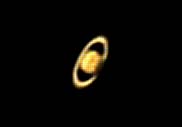
Subject: moon photo Sent: Saturday, January 11, 2003 16:59:28 From: etxjim@yahoo.com (jim abbey) This an obvious moon photo and to date one of my best.All Im using is an aiptek DV2 digital still and vidio cam , not an expencive camera by any means, But its giving me practice! Im just mounted the cam on a tripod and positioning it in such a way that it will show the picture of my subject in the lcd view finder.
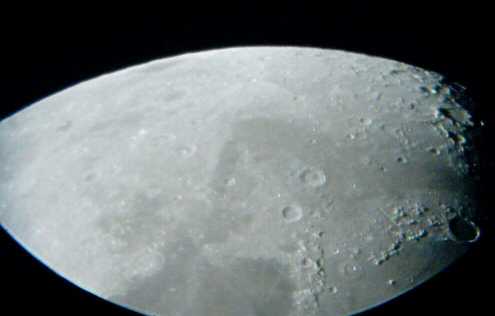
Subject: ETX 90 moon image Sent: Monday, January 13, 2003 12:09:49 From: Tom.Alderweireldt@pandora.be (Tom Alderweireldt) It's been a while since I last used it, but on Jan 11th I took several webcam images with my ETX 90 and combined them into a mosaic view. I hope it helps to encourage ETX users to see what such a little telescope can achieve. Time and again it amazes me how fantastic the optical quality of this thing is. The webcam was a Philips ToUcam, each part of the mosaic is about 150 stacked frames. Regards, Tom Alderweireldt Belgium.
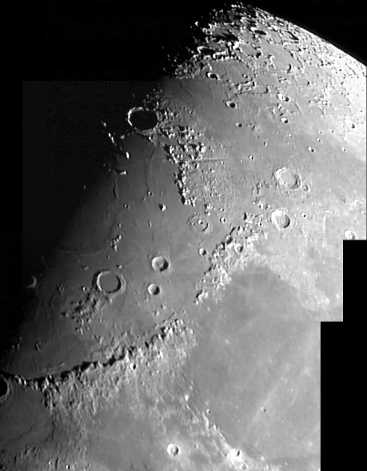
Subject: guidescope for ETX 125 Sent: Tuesday, January 14, 2003 2:15:06 From: kris_vanmol@msn.com (Kris Van Mol) First of all lots of succes and clear skies for 2003! I need some good advise, maybe you can help me? I am getting my etx 125 ready for planet photography. I already used a toUcam xs (soon a pro), a 5 meter network cable, a barlow 2X and soon i will have a electric focuser. Now my question; it is hard to find a planet back when you lost him out of sight with that small field of view of a webcam. Now I wanted to find something to have a kind of guidescope with another webcam to have a larger field of view on my screen. I fabricated with an old camera objective (4/200) and another webcam a sort of guidescope, but I have no idea how to fix it on my ETX!? I even want to use software that correct the scope movement using that guidescope (i have the connection cable kit too). It is possible that i have to use two toUcams pro for this because of the lightsensivity. Do you now if there exists some software that can track with the guidescope AND use in meantime the other webcam to stack or film the pictures of the ETX tube? I already thougt about IRIS but this one is not able to recognise two different webcams. Greatings, Kris Van Mol BelgiumMike here: You could likely make a "piggyback" style adapter for the 2nd webcam. There are some tips on the Help Information --> Astrophotography page. As to autoguiding the ETX, that would be a challenge as the ETX drives don't track that evenly and the Autostar does not have any "PEC" (Periodic Error Correction) capability. But I like your idea of the 2nd webcam for centering the object. I don't know of any software that handles two webcams simultaneously.
Subject: GUEST PLANETARY ASTROPHOTOGRAPHY Sent: Tuesday, January 14, 2003 11:34:05 From: a.hatwood@net.ntl.com (a.hatwood) With Saturn at opposition in mid December 2002 I couldn't resist trying to capture it. The image is a composite of over 600 shot, taken in sets of around 60. I used a QuickCam Web, at prime focus and a 2x Barlow fitted to an ETX 125. I compiled the image with Astro Stack. The sky in Wales was lovely and clear that night, but the seeing wasn't great. Hope you can post it on your site, Thanks, Tony Hatwood
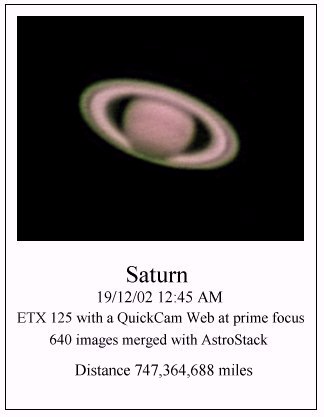
Subject: picture of Jupiter Sent: Friday, January 17, 2003 12:57:58 From: skater102001@yahoo.de (Georg Bhme) I shot this picture of Jupiter with teh etx90 and a Toucam - pro and photoshop 6.I stacked 100 pictures with Astrostack together. The time was 9:45 PM in germany. This picture shows what you can do with it not what you can see at the first time.

Subject: images of the moon, jupiter and satrun Sent: Sunday, January 19, 2003 14:01:10 From: titou@minititou.com (titou) My name is Didier. Here are 4 pics taken between Dec 12 2002 and Jan 14 2003. The pictures are rough ones, with no treatment of any kind. They were all shot with : Meade ETX 90 EC Barlow x2 lense Philips VestaPro not altered These pictures were shot in Grenoble (French Alps) : full East, Grenoble: 4511 543. do contact me if you want to exchange pictures!!! Happy new year from Grenoble capital of the Alps!
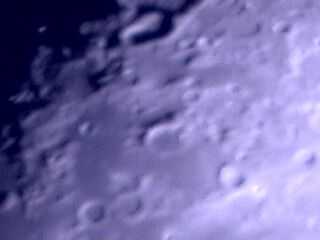
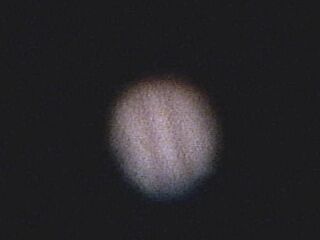
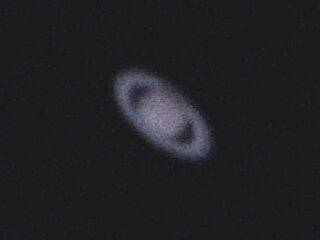
Subject: Jupiter Sent: Monday, January 20, 2003 9:27:41 From: jlecomte@easyplanet.net Here is my latest picture of Jupiter. MEADE ETX 105 EC + apochromatic barlow 2x + Webcam Philips TouCam PRO. Processing using IRIS (http://www.astrosurf.com/buil) and photoshop. Julien Lecomte
Subject: 'Webcaming' Jupiter and Saturn Sent: Thursday, January 23, 2003 3:18:39 From: Dieter.Wolf@DNSint.com From: Dieter Wolf, Munich, Germany (backyard in the city) please find attached my first Webcam photographs.Mike here: Stacking does improve image "quality" by "removing" noise. This noise can come from atmospheric distortion or imager electronic noise. However, it can also create false details if carried too far.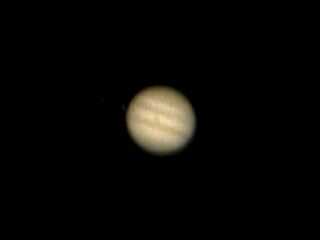
Jupiter (IO and Ganymede shadows) Meade ETX-125EC, 1900mm prime focus, Philips ToUCam Pro, abt. 15 out of 150 images stacked with Giotto; 17.01.03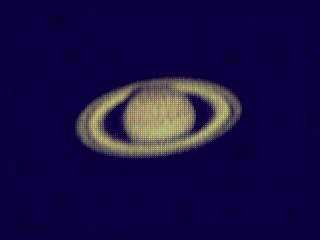
Saturn (Cassini and shadow on rings) Meade ETX-125EC, 3800mm prime focus, light yellow filter, Philips ToUCam Pro, abt. 15 out of 150 images stacked with Giotto; 20.01.03 You ask me if I'm proud of them? Yes Sir, I am! Do you remember when you saw your first fuzzy picture on the Notebook LCD? You'll probably never forget it! Looking through your site in the 'Helpful Information - Astrophotography' and 'Guest Astrophotography Gallery - The Planets' area, I found some interesting photos to compare. Some are better, some are worse. Well, there's a lot left for me to learn, try and 'play around' with stacking. But what I would like to discuss with you - or some readers of your lovely page - is: How does someone like e.g. Xavier Ray-Robert create a 'high-glossy' image out of fuzzy brute pictures (at least - or even more - 'fuzzy' than mine)? In my experience, all treatment of pictures - whilst or after stacking - comes to an end either at sharp, clear pictures containing artefacts instead of details or at still somehow fuzzy pictures showing only 'real' details'. Again, what's the 'trick' with it (yes, I tried different filter combinations and grades)? Always clear skies - it's raining here in southern Germany..... Dieter
Subject: jupiter Sent: Wednesday, February 5, 2003 11:31:27 From: skater102001@yahoo.de (Georg Bhme) I shot this photo of jupiter with my etx90ec and a Toucam-pro at 8:10pm in germany.I put 30 images with giotto together.
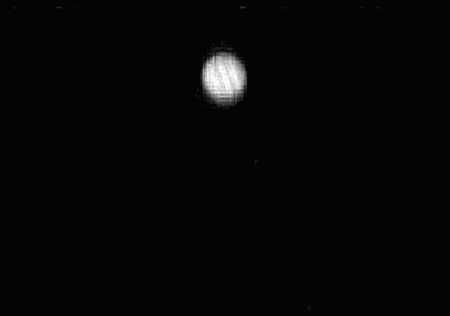
Subject: Saturn Sent: Saturday, February 8, 2003 9:46:44 From: skater102001@yahoo.de (Georg Bhme) I shotn this photo of Saturn with an ETX90ec and a Phillips Toucam! I used a 26mm eyepiece and a 2x Barlow 3-element apochromatisch(#140). I shot this foto at the 8.2.03 at 6:45pm in germany.I shot this photo of Jupiter in the same night. 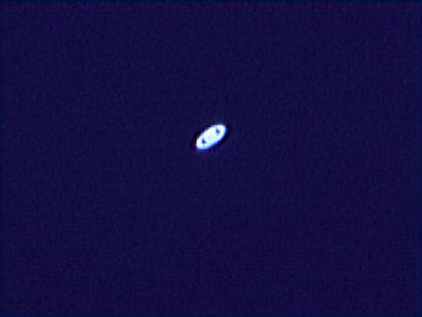
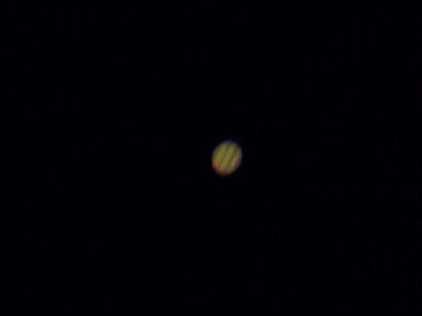
Subject: My ETX aniversary (Saturn and Jupitar) Sent: Monday, February 10, 2003 11:40:59 From: k2_71828@yahoo.es (Kacper Wierzchos) I would like to show you and visitors of your amazing web-site my progress in one year of dedication to astrophotography with web-cam and ETX90EC. From first nights I have try to obtain some images with Philips TouCam 740K following your indications and taking into account valuable comments of your web-site visitors. The very first results from February 2002 (Jupiter and Saturn) of these efforts you can see in first raw of attached figure. After one year of experience the results become to be acceptable as you can see in second figure raw (and some deep sky images on your web posted in January 2003 section Deep Sky and Astrophotography). The aim of my present postage is to show a newbie that first step in astrophotography can be difficult but dedication and experience may lead to the nice results. Description of First Anniversary Jupiter and Saturn images: place Lerida (Spain), urban sky buy very stable atmosphere on 8/02/2003; ETX90EC (#884 tripod, Autostar, Az.-Alt. mount) and Philips TouCam 740K with 2x Barlow; series of *.avi files (300 images, 5 frames/sec., 1/25 exp., brightness 50%, gain 70%) record with K3CCD and aligned and stack with Registax (best 100 frames); post processed with Photoshop (C/B, levels, unsharp mask and Gaussian Blur). I hope you will find these images adequate for your The Planets (Guest Astrophotography Gallery) Section. Kind regards Kacper Wierzchos

Subject: Planets Sent: Sunday, February 16, 2003 15:53:04 From: geheniau@xs4all.nl When I woke up at seven in the morning I saw Venus. So I quickly made a shot of it with my ETX90 and a webcam. Just 1 frame not stacked and seen through a window. It was too cold to go outside and I was still in my pyama's :-) But...it is Venus!.A special one. You can see Ganymede and it's shadow on Jupiter. Happens not often!. Taken with my ETX90 and a webcam toucam pro. Stack from 100 frames. 
Nice stack from saturn with my ETX 90. 100 frames with toucam Pro. 
Job Geheniau The Netherlands. 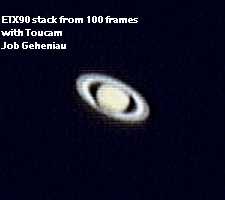
Subject: Jupiter Picture Sent: Saturday, March 1, 2003 9:26:43 From: aptyler@hotmail.com (Adam Tyler) Taken 2-27-2003 from the Detroit, MI area (see attached). I strapped a Creative WebCam Pro (with lens removed) onto a 2x shorty barlow and took about 500 frames of uncompressed AVI through my ETX-105. I used VirtualDub to capture the video, and Registax to process the frames. The original 640x480 picture has been cropped. Adam Tyler (aptyler@hotmail.com)
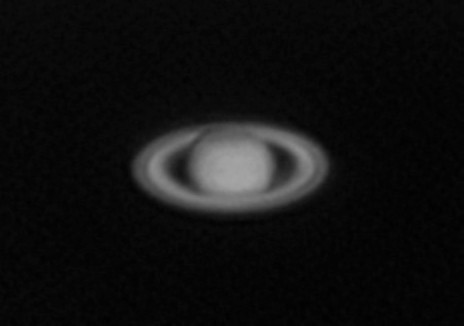
Subject: Jupiter shot with ETX Sent: Thursday, March 6, 2003 10:18:25 From: olivier.cioni@wanadoo.fr (Olivier Cioni) First pictures I took with an ETX105 and a toucam Pro on my own web site: http://www.astrosurf.com/astro-c. Olivier
Subject: Jupiter Great Red Spot Sent: Thursday, March 6, 2003 17:12:32 From: geheniau@xs4all.nl It was a lot of work, but this is my result with my ETX90, a 2x Barlow and a Toucam Pro webcam ( 230 images stacked ). The Great Red Spot is clearly visible! Greetings Job Geheniau The Netherlands
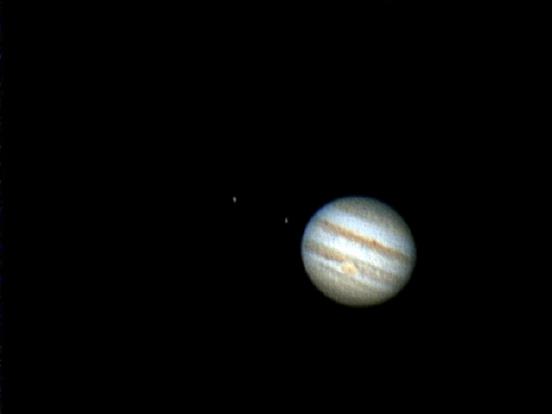
Yesterday I send you Jupiter. The same evening I did Saturn with my etx 90, barlow x2 and a toucam pro. I saw some spots which I enhanced a little bit with Photoshop. (after registax (195 images stacked)). It could be stars, it could be moons or it could be webcam distortion, but they were 'clearly' visible in the original so important enough for me to enhance them. Thanks again for your great site from which I learned a lot! Greetings Job Geheniau The Netherlands www.xs4all.nl/~geheniau
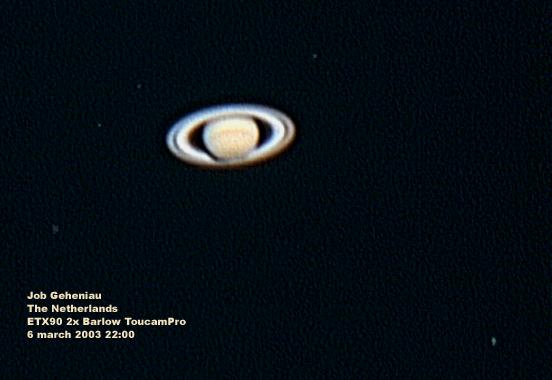
Subject: Webcam image Jupiter & moons
Sent: Friday, March 7, 2003 8:16:10
From: Dieter.Wolf@DNSint.com
please find attached a Webcam 'shot' of Jupiter & moons. That day, all
four Galileian's lined up, three of them within the field of view.
Who: Dieter.Wolf@DNSint.com (Dieter Wolf Munich, Germany)
What: Jupiter with IO, EUROPA, GANYMED
When: March 04th, 2003; 22:00 UTC
With: MEADE ETX-125EC (5" / 1900mm), Philips ToUCam Pro (Prime
Focus, 1/33s), 150 out of 250 Frames, K3CCD / Giotto
Have yourself a fine wekend,
Dieter
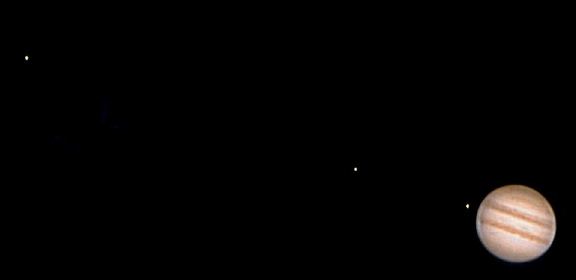
Subject: revamped website Sent: Saturday, March 8, 2003 2:49:34 From: mjcripps@ukonline.co.uk (mjcripps) I thought that you may be interested to know that I have revamped our website (www.neatherd.org/astronomy/index.php). It now includes a section recommending 'Home Astronomical Observatory kits' for schools, which are centred around the ETX70, ETX90 or a Newtonian/Dob. There is also a page about imaging. We are starting to have great success with our Philips Toucam Pro webcams and I attach a picture I captured of Jupiter and two of its moons using an ETX 105. The picture is composed of one exposure to capture the moons and 15 for Jupiter which were then stacked with astrostack and adjusted using photoshop. All exposures were taken within about 5 minutes of each other.Your readers who are beginner Sun observers may also be interested in our 'Our Star*' project, designed to help our astronomers make studies that link their observations with small scopes to data from the best ground and space-based observatories. Also on the site are details about our forthcoming link with NASA through the International Space School Educational Trust. I shall be visiting Kennedy Space Station in May and hope to "network" (personally I prefer the description "talk and make friends"). If there are any NASA people in the ETX community I would very much like to hear from them. A lot has happened in a year but I've said it before and I'll say it again; I don't think any of it would have happened without the information from the ETX community on your site and your personal help and advice. Regards Mike Cripps 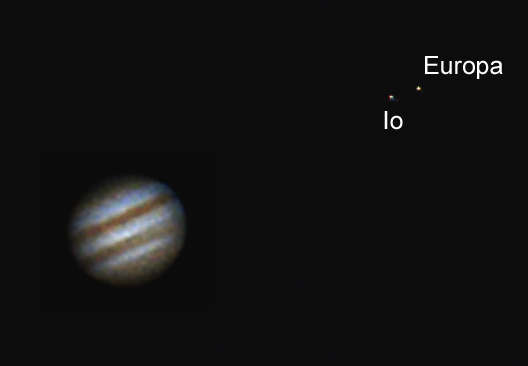
Subject: PLANETARY ASTROPHOTOGRAPHY, Feel free to post Sent: Thursday, March 27, 2003 22:01:27 From: timorley@fuse.net (Tim Morley) I took these with my ETX125 the evening of March 26. The color Saturn and Jupiter images were taken using an IBM WebCam I adapted. The black and white Jupiter image was taken using the Meade Electronic Eyepiece. Each image is the result of stacking a 10 second video capture using Registax. A 2X barlow was used for the Jupiter images. Tim
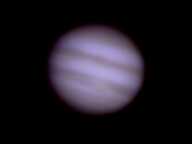
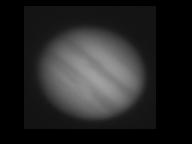
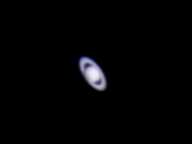
Subject: Meade Etx 70 at Expirement Sent: Sunday, April 6, 2003 17:53:11 From: alex_cashshadow@hotmail.com (Alex Cashshadow) I took these pictures of the Moon and Mars Tonight here in Toronto,Canada. I have recently bought a Webcam that i thought would be a good choice with my etx 70 at. I took these two pictures with my etx 70 using a Meade 25 mm and a Antares 3x Barlow lens from efstonscience here in toronto.I held the Webcam up to the eyepiece and i took these 2 pictures. I dont think they are bad,for a first try. If you know a way to make this better please tell me.Mike here: One is obviously the Moon but the other (smaller image) is not that obvious that it is Mars. Looks too large a disk for the ETX-70AT and the phase is wrong. I suspect the webcam moved during the exposure. Mounting a camera to the eyepiece works out much better for longer exposures. The Moon is slightly overexposed so if you can control the exposure, shorten it.Happy Nights Everyone Alex Casciato 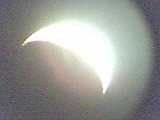
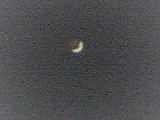
Subject: Castor Sent: Thursday, April 17, 2003 15:55:31 From: geheniau@xs4all.nl Here the Double Star, Castor. Made with ETX90, 3xBarlow and Toucam Pro. Just 1 frame grabbed from movie. Job Geheniau The Netherlands
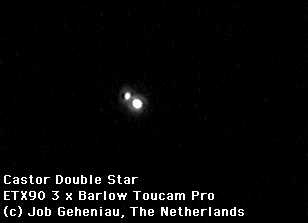
Subject: Request for image post Sent: Friday, April 18, 2003 19:19:01 From: cmf@san.rr.com (Chuck) I was impressed to see what others had done using a web cam, so I thought I would try it myself. This image was taken from my backyard here in San Diego. Thanks for your efforts in creating and maintaining the Mighty ETX! Chuck Falcone
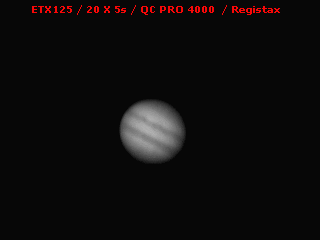
Subject: Toucam Jupiter pic Sent: Monday, April 28, 2003 23:26:01 From: jbowers1@mindspring.com (CVL) First of all, congratulations on such a fine ETX site. Without a friend of mine pointing out your site and the wonderful tips it contains, I don't think any pics would have materialized from the ETX. One of the first modifications that really helped out the scope was the drive mod with the 2 switches. Before that, it was a lot of locking and unlocking the RA to stay on a planet (or whatever else) only to watch the object drift out of sight once the RA was locked. Now I just push the correct button. Thought I'd enclose my first Toucam Jupiter pic taken on April 27th. Approx. 300 frames staked in K3CCD tools. Unsharp mask also applied. Taken through diagonal of ETX-90RA. Enjoy! K3CCD tools is a freeware stacking program. I never even heard of it until I started reading the QCUIAG message board on Yahoo. Although I used just the plain Toucam software for capturing the Jupiter avi (my Pentium 166 is just too old to accept K3CCD), K3CCD allows capturing to avi, aligning, stacking and some post processing, like histogram and unsharp masking. So, once captured to an avi, I sent the avi to the P4 for processing with K3CCD. The program is pretty much automatic- it has a planetary guide that takes you through the processing step-by-step. You can even hand select the best frames for stacking, although I didn't do it for the pic I sent you. I also have Registax which is extremely useful for the sun and moon, but it didn't help as much with Jupiter as K3 did. The hardest part of the entire process seems to be both proper webcam settings for capture and keeping the object being imaged centered on the tiny ccd (with webcam lens removed). The URL for K3 is http://www.pk3.org/Astro/. I couldn't even begin to see the red spot until after stacking in K3CCD tools, so it does seem to make a tremendous difference. I also have a regular digicam (Nikon 4500), but I'm sold on the idea of using webcams for planets due to the great results obtained. The greatest advantage is being able to take an avi and separate it into its original frames, and there can be up to 600 frames to work with. John
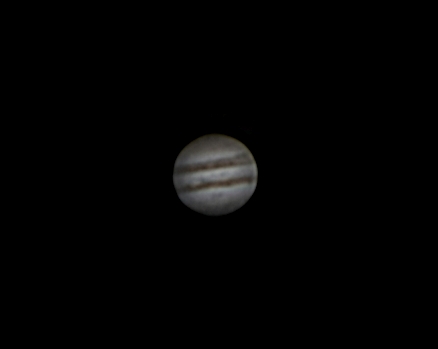
Subject: Jupiter photo Sent: Friday, May 9, 2003 21:35:57 From: r.laffoon@verizon.net (Larry Laffoon) Here is the first photo I took of Jupiter taken with a ToUcam and the Meade 125. A 2X Barlow was used. K3CCD Tools, Registax and Photo Shop 2000 were used in processing the photo. It is the best 43 frames from a 378 frame, 5 fps AVI movie file. I have more pictures posted on my Astro Video web site: http://mysite.verizon.net/vze3yc34/index.html I hope to be using a 3x barlow soon, which should be interesting! Especially from Maryland! I know you get tired of hearing it, but it can't be said enough - "thanks again for a great web site". Larry
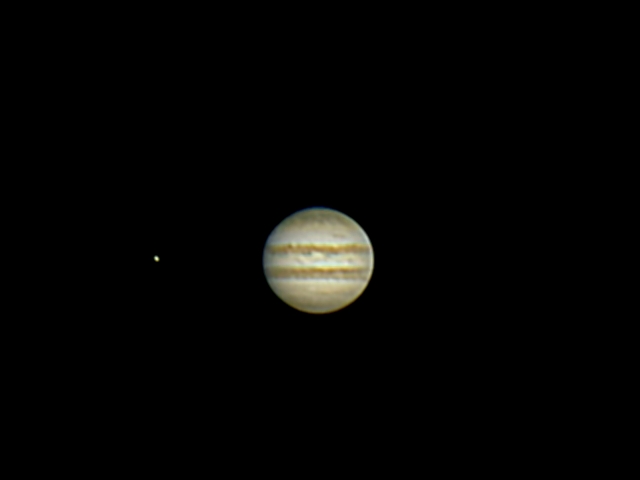
Subject: latest and best Jupiter and moon pics! Sent: Monday, May 12, 2003 08:32:50 From: jbowers1@mindspring.com (CVL) Attached are my latest Jupiter and moon pics. Please feel free to post! Both were imaged on May 11th. Seeing was 8/10. Here's the Jupiter specs: 500 frames captured as avi in K3CCD tools. Automatic frame selection, aligning, stacking and processing done in Registax. Postprocessing consisted of slight color adjustment and 40% enlargement. Equipment used was ETX-90RA, Toucam with IR filter in place, and Meade 2 x barlow. NOTE: Using the IR filter and straight through Mogg adapters (as opposed to imaging through the diagonal) seems to make a big difference in color and focus! Moon specs: 50 frames captured as avi in K3CCD. Auto frame selection, aligning, stacking and processing done in Registax. Cropped slightly to reduce noise at edges. Noise reduced with Neat Image. Equipment: ETX-90RA, Toucam with IR filter, Meade 2 x barlow. Enjoy! John Bowers
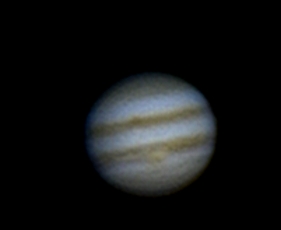
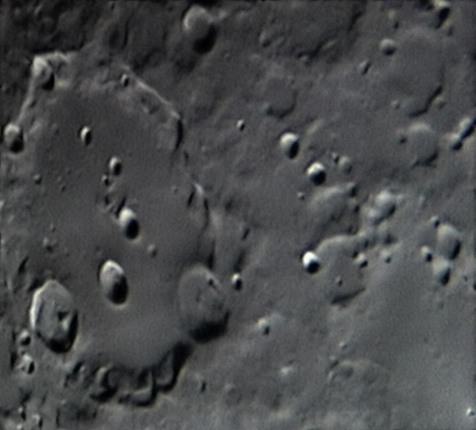
Subject: Jupiter Photo Sent: Saturday, June 7, 2003 11:52:33 From: cmf@san.rr.com (Chuck Falcone) Attached is the lastest Jupiter image I took using a unmodified quickcam pro 4000 on a ETX125EC. This image was acquired by an AVI at 25 frames per second for 10 seconds on daylight setting. I adjusted all other camera settings until I got a desireable image on the screen. I would have like to give the actual settings, but I forgot them. Anyway the settings seem to changed depending on the seeing conditions. Then I used Registax to align and Photo Explorer for further enhacement, ie... focus, saturation and balance.Mike here: Good deep sky astrophotography is challenging and rewarding. But it can be very much a trial and lots of errors thing, especially with an ETX.I'm considering going to a long exposure camera but I'm not sure how difficult it is to take good deepsky photos. As with this image it took some time to get to this point. I want to make sure it remains fun and not a labor. If you have any opinon on this it would be greatly appreciated. Thanks for your time, Chuck Falcone 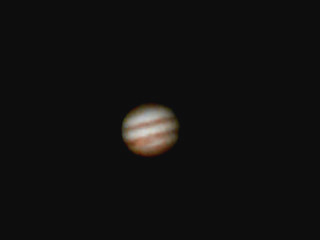
And:
Attached is the last photo I took of Jupiter using a Quickcam Pro 4000. I shot a AVI at 25 frames per second for 10 seconds on the daylight setting. I adjusted all other settings until I had a good image on the screen before capture. I then used Registax for algining and Photo Explorer for additional image enhacment...ie focus, saturation and hue.Hope to see you at Oceanside Photo and Telescope. And again, Great Website, 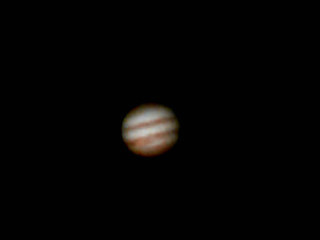
Subject: ETX photos Sent: Friday, July 11, 2003 00:52:03 From: geheniau@xs4all.nl I've been doing some observations the last week. attached 3 new pictures. I like to try to get the deep sky objects with an ETX90. It's difficult but a challenge.The M27 image will be better soon, because I had only the opportunity (for different reasons) to take 2 exposures from M27 instead of 20 or more. Mars will also be beter, because this image had been taken from within the house through a window, but the result is ok for now. From 8 to 22 of August I will be on holiday on La Palma (NOT LAS PALMAS) the island with the great observatories!. I also take my ETX90 with me so I expect to do some nice photography there! For now I only have to do 107 out of 110 Messier objects with my ETX :-). See www.samage.net/~geheniau/astronomy.html Greetings, Job Geheniau The Netherlands
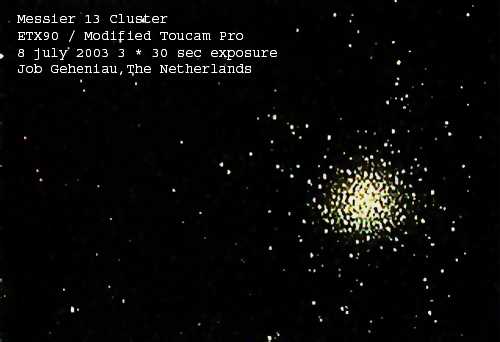
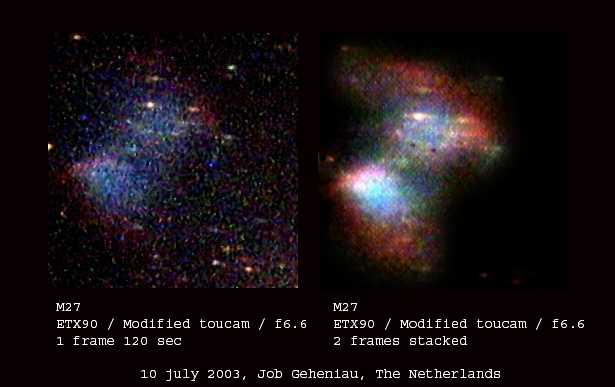
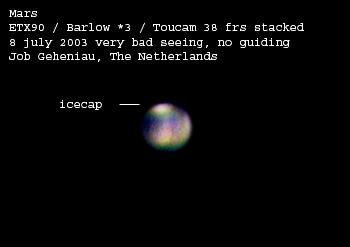
Subject: Observing results Sent: Saturday, July 19, 2003 06:29:23 From: geheniau@xs4all.nl Last night I had a good night here with my ETX. But still have much trouble with light polution and the summer nights here. Job Geheniau The Netherlands
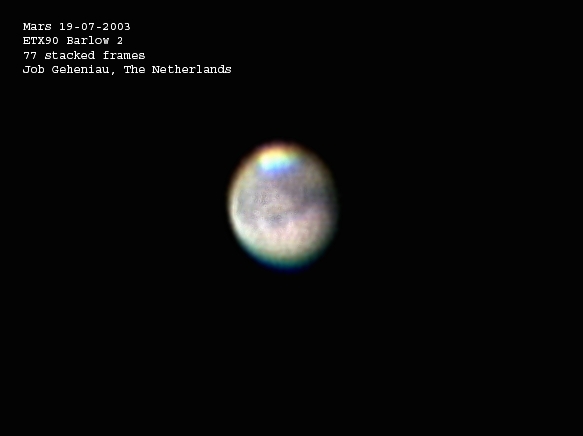
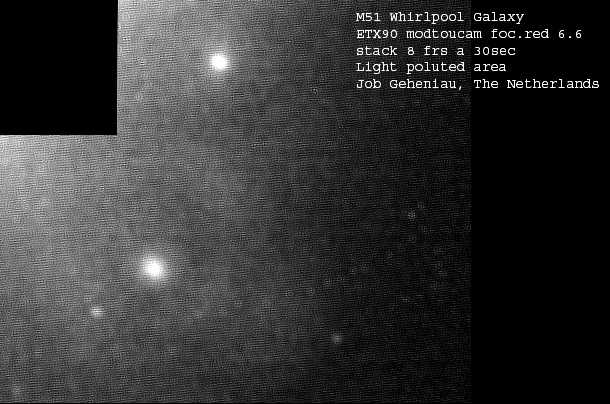
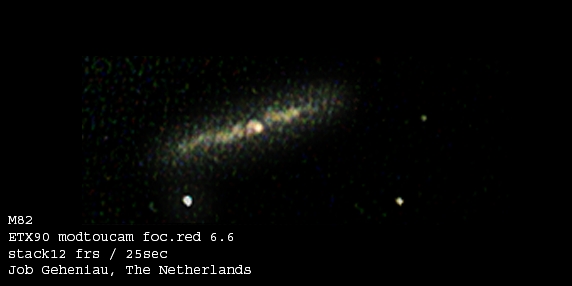

Subject: ETX-125, ToUCam, and MARS!!! Sent: Thursday, July 24, 2003 07:01:46 From: Lang.Michael@orbital.com (Michael Lang) I've been having Autostar problems since loading 26eD (reference my question a couple weeks ago on training and target distances). After reviewing everything I could find on your fine site pertaining to my problems, it occurred to me: (1) Mars is getting close fast, (2) I've been dorking around with my Autostar and ETX-125 in Alt-Az alot more than I've been viewing Mars, (3) I get about 1 night in 7 of relatively clear skies, and (4) I've got a new ToUCam Pro (740K) Web Cam I've never used on my ETX-125. So I got up at 2 AM last night, polar aligned my ETX-125 using the no-brains (and no frustration) non-Autostar hand-controller, slewed around to Mars, and it was nice and steady with details showing. I installed the ToUCam+2X Barlow and Laptop, and HOLLY MACKEREL I was getting pictures like those I see on the web! My advice to all out there with an ETX, drop the Autostar, if your having problems, buy a ToUcam and the 1.25 inch adapter, a prime focus 1.25 inch screw-on adapter, and a 1.5 to 2X Barlow (get a good one like a Celestron Ultima) and get going on your Mars observing tonight using the Hand Controller. I tracked Mars until dawn with very few corrections required in over two & a half hours. The controller is responsive, doesn't rubber-band or do any of the AutoStar silliness, is simple to use in the dark, and keeps my blood pressure low. This all gave me the time I needed to focus on just imaging Mars, tweaking the ToUCam settings, experimenting with the K3CCD software, and just practicing. A few additional pointers: (1) Since the CCD in the ToU Cam is so small, it's pretty tough to get the image of Mars on the chip,especially at high power. So, align the Finder Scope using your highest power eyepiece (I used a 4.8mm Nagler). Then defocusing Mars so it forms a large blob that extends into the "4 quadrants" formed by the finder scope crosshairs. Adjust the Finder Scope so the blob equally fills each quadrant in the finder. Keep tweaking everything until Mars is centered in the eyepiece, and Finder. Then install the ToU Cam, (and remember to flip the ETX mirror down to the prime focus position), and if the image is centered, great!! But it won't be. So don't get frustrated, just start searching. Have the Laptop positioned such that you can see it out of one eye, while looking into the finder with the other. Get comfortable in your observing chair, and slew the scope around using the lowest speed on the Hand Controller, and all the patience you can muster up. Eventually you'll find Mars. When you do, either make a mental note of how the blob looks over the crosshairs, or try and tweak the finder (but that's tough to do without loosing Mars again). I found getting Mars back into the field of view was easy by just positioning the defocused-blob over the cross hairs the same way as when Mars is displayed on the laptop screen. (2) Drag an extension cord out to power your laptop (scope to if you aren't using a big external battery), my Laptop battery died and I lost 15 minutes. (3) Build a LOOOOOOOOONG lightweight foam dew shield, or you're front lens will probably dew-up, and you'll be sad. I followed the advice of the gentleman over seas, and the results are just wonderful, (4) Buy some of those shock-absorber pads for your tripod feet. They really work and are worth every penny, (5) Get comfortable, put your Laptop on a small table, like a lawn furniture table, or one of those fold-up dinner tables, and put your self on a chair or stool (note: this may seem silly, but a 3-leg stool is much better than a 4-leg when your moving around a 3-leg tripod - less bumping), and finally, get your scope outside hours before your gonna get serious about observing, and let it reach thermal equilibrium. The images are dramatically improved after the scope cools down., (6) Either install an electric focuser, or a "flexi-shaft" focuser, and then keep tweaking/experimenting with the focus during your session, (7) Use K3CCD (shareware) to record your AVI's, it's much better than the Phillips S/W that came with the camera, And set the camera "gain" low, and the "shutter speed" high - but experiment until you understand the relationship between these adjustments. Also play around with the "Daylight", and "Outdoor" settings until the color displayed matches reality (as viewed in the eyepiece) (8) And finally, practice using everything during the day, or inside. It's easier to get familiar with everything in the light when your wide awake, than to fumble at night for the first time. Now as far as what to do with the saved images, I haven't done anything yet. But from reading many Web "how-to-do CCD astrophotography", it seems "Registax" is the preferred post-processing, "first step". And if you have Photoshop (I do), that seems to be a good choice as well. Also, checkout the Sky&Telescope article from July (or August ) of 2003. There's a good article on how to get started in CCD astrophotography. I'll post my Mars "first light" pictures in a few days when I figure out how to process it. Unless observig conditions keep me outside the next few nights. And one last thought: this is really FUN !!!!!!! Mike Lang Aldie, Virginia
Subject: Re: ETX-125, ToUCam, and MARS!!! Sent: Monday, July 28, 2003 08:16:04 From: Lang.Michael@orbital.com (Michael Lang) The camera/eyepiece adapter I use on my ETX-125, simply screws onto the threaded ring on the back of the ETX (after removing that threaded cap). It is about 50 cm long, and is also threaded on the other end, such that you could screw that threaded cap onto it. The inside diameter is 1.25 inches, and there is a small knurled screw at the "eyepiece end" to lock your eyepiece or Barlow + camera adapter into the threaded adapter. I can't remember where I ordered it - but you might try searching Mike's site or asking Mike. I would be surprised if Scopetronix doesn't stock a similar adapter. I was outside all night Friday (July 25) and captured over 20 avi's using the setup I described in my previous message on Mike's site. I noticed that seeing gradually improved over several hours, no doubt due to the scope temperature equalizing, and Mars climbing higher in the southern sky (and I have to tell you - I'm VERY JEALOUS of your location - your view of Mars is going to be fantastic !) I also noticed a blue fringe on one limb of Mars, apparently due to atmospheric refraction as a result of Mars being so low in the sky. I used K3CCD to capture the avi files. My Laptop is slow, so I captured 5 frames per second to avoid dropped frames, shutter was 1/33, gain & gamma were set low. I used a 2X Celestron Ultima Barlow, Thousand Oaks Light Pollution filter (visually, this seemed to improve image contrast) Telescope was polar aligned, and I used the Hand Controller versus Autostar. Side Notes: I ordered a Baader Contrast Enhancement Filter, and will let you know how that works after I receive it. Also: I intend to try a Wratten 23A light-red filter next. I tested it on the ToUCam, and the camera is plenty sensitive with a 23A filter, and red filters are supposed to bring out surface detail, and limit sky glow, atmospheric turbulence, and perhaps "blue-fringe". K3CCD has a small symbol in the toolbar that says "FFT". I'm not exactly sure how it works, but it appears to generate a star-pattern with rings when the best focus is achieved. And finally - I noticed that setting the ToUCam to image in Black & White increases resolution in my tests images of a red brick wall several hundred feet away, illuminated with a red Light Emitting Diode. And now back to my Mars image: In my 18th avi (3:55am), everything came together - the atmosphere was stable, telescope focus was perfect (get an electric focuser if you don't have one, and modify it per info on Mike's site, to focus as slow as possible. Also I've made a special mechanical modification to my electric focuser that completely eliminates mirror shift - for about one dollar ! - details to be provided in another message ) So in the 18th avi, I could tell the conditions were just right, so I set K3CCD to record 200 frames (in previous attempts I only recorded 50 frames). Here's the results after stacking 57 of the best of 200 frames using K3CCD:Then I used Photoshop 3.0 to sharpen the image using "Gaussian Blur" + "Unsharp Masking" + Contrast & Brightness adjustments: 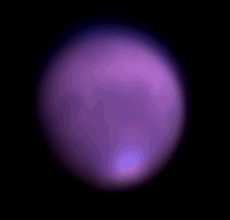
Finally, I used Photoshop to adjust the color to more accurately reflect the real color of Mars (at least what I think it looks like from various spacecraft images. I considered some pretty drastic measures to correct the blue fringe around the southern ice cap (air-brushing), and just couldn't do it. And actually, it reflects the reality of my viewing location: 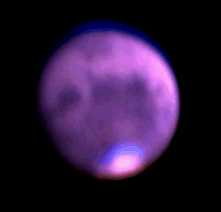
Not believing the results, I referenced recent back issues of Sky & Telescope, and found a pretty close match in the June 2003 issue (page 97). It looks like my image may be of the "Syrtis Major" region. And there you have it. Let me just reiterate: if you have dew problems in Africa, get a long dew shield, and get comfortable: have a chair, and locate your laptop on a table. Your going to spend long periods sitting very still watching the monitor, adjusting focus, centering Mars, focusing, adjusting the camera settings, re-centering, focusing, holding you breath........... But when the sky begins to brighten, and you finally go inside and begin processing your catches from the night, the thrill of comparing your first picture to a map of Mars, and seeing a match is just too exciting for words! Michael Lang Aldie, Va. 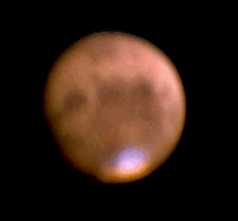
Subject: Mars, ETX125 and ToUCam Sent: Monday, August 11, 2003 21:51:57 From: viking5@bellsouth.net (the Christensens) I always enjoy your ETX web site. I have had my ETX 125 for more than a year now and I am comfortable with its operation thanks to the wealth of information you provide. I recently aquired a Phillips ToUCam Pro along with a 1.25" eyepiece adapter. I wanted to share my images and experience with you and your readers. After some study, I decided that the Phillips ToUCam Pro was the best way to go. It has a CCD imager instead of the CMOS type in less expensive webcams and has better than 1 lux sensitivity. The removable lens makes it easy to attach the telescope adapter, you simply unscrew the lens and replace it with the adapter. The camera assembly weighs less than most eyepieces so no counterweighting was necessary. The camera and telescope eyepiece adapter were $150 from Adirondack Astro Video (www.astrovid.com). The first clear night I attempted to capture Mars, but my results were poor. I was using "auto mode" and the provided "Video Lounge" software that came with the camera. The videos were grossly overexposed - all I got was a fuzzy white ball. After more research, I downloaded several programs, and finally settled on K3CCD. It seemed to have more features than I understand, but menus I could follow and operate. This past weekend (Aug 9, 2003) skies were clearer and I once again tried to get Mars. I knew the images I previously captured were too bright. I unchecked "Auto Exposure". Then I adjusted the gain, brightness and contrast to their center values, then adjusted the shutter speed to where I could clearly see the polar cap and some dark features at 1/250sec . I fiddled with the gain, brightness and contrast some more (shifting them to the left) to improve the image quality. I found it difficult to keep Mars centered and it was also difficult to focus - there is a few seconds lag between the time the image is taken and presented on the notebook's screen. Slow cautious deliberate focusing and aligning was required. I rarely use "SPEED 2" on the Autostar controller, but I did for this. (I owe much thanks to Clay and Dick for their Autostar programming information, without which the creep after beep and lag in the motion controls would have made this improbable!) K3CCD has the ability to capture various video streams, being able to select the number of images per second, and the total number of images, etc. I settled on 2 images per second for a total of 100 images, which produces a file about 45mb. I proceeded to capture several videos, varying settings slightly. I subsequently "aligned and stacked" the best of them to achieve the included picture. While not as good as many I have seen, I was pleased with my "second attempt". You can clearly see the southern polar region and dark markings. I want to further experiment with colored filters and use a 2x barlow. I will send future results and I hope to provide some instruction as well. I found this process very "trial and error", but I believe it can be simplified so that others can have a successful and positive experience. Brian Christensen Viking5@bellsouth.net Hoover, Alabama
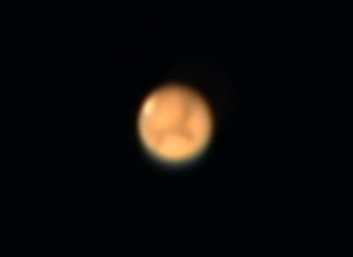
Subject: Imaging and Processing Mars using ToUcam and Registax Sent: Sunday, September 14, 2003 13:45:15 From: fishonkevin@sbcglobal.net (kevin keyes) While visiting your sight I have found the pictures submitted by other Skywatchers to be very good. Especially those taken with webcams, particularly those taken with the ToUcam Pro and stacked in Registax. But to my dismay and frustration I have not found any " Tips or Pointers" anywhere on the 'Mighty ETX' site for either imaging with a webcam(settings, etc.) or stacking using Registax. I did a web search and found 2 guides written by Alan Chu, these guides really helped me image and process my first 2 Mars photos(attached). The addresses for the guides are http://www.hkedcity.net/iclub_files/a/1/98/webpage/Hot_Topics/ToUcam_guide1.doc and http://www.hkedcity.net/iclub_files/a/1/98/webpage/Hot_Topics/Registax_guide1.doc (Microsoft Word files). As a beginner I couldn't have got thruogh Registax without them. The 2 photos were taken with my ETX-125(Polar Mount), a Meade #140 2X Barlow, a ToUcam Pro with settings from Alan's guide. I then stacked and processed in Registax, again using the settings from Alan's guide. I can't wait to try for Jupiter and Saturn this winter. Outside in the Dark, Kevin Keyes
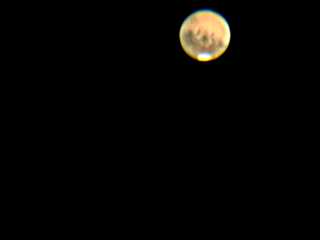
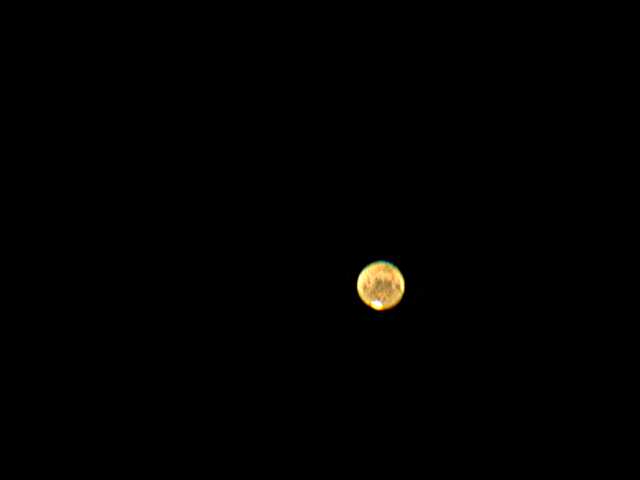
Subject: My Photo Gallery Site Sent: Monday, September 15, 2003 15:19:59 From: cstar@san.rr.com (cstar) I have just recently opened a photo gallery on the web. It contains images of the planets that I took with a webcam with my ETX125EC. Could you post this on your site for others to access? Thank You! Chuck Falcone falconect.smugmug.com/gallery/24016
Subject: Webcam astrophotography Sent: Friday, October 10, 2003 07:49:06 From: LOGIACCO_MICHELE@LILLY.COM again great compliments for your very useful website. That's the second time I write to you. I'd like to know what follows. Alan Chu enclosed an interesting Word document about WebCam (title: "ToUcam Guide"), but I did not understand how he obtained the equivalent focal lenght of his optical system; is it possible to have the formula ? I have one but I am not able to have the Barlow focal length to compute it. Is it possible to have some basic info about astrophotography by means of the Webcam Toucam Pro, using the Iris software to process the photos ? I cannot find them in your website; I only saw some photos but not the description to obtain them. I'm trying to practice the astrophotography with my ETX 90EC, but not with the same results as ones in the site. A basic introduction to some concepts, like best exposure time, gamma, luminance, stacking and so on would be very appreciated, if possible. Thanks a lot, Mike. Regards Michele
Subject: Saturn oct 12th 2003 Sent: Sunday, October 12, 2003 13:18:50 From: Dimitri Koens Congrats with your sites 7th anniversary! This is my first attempt on Saturn. This is what I used: - Meade ETX-105 - Philips ToUCam Pro II on Meade Super Plossl 9 mm - Exposure: 1/33s - Stacked with Registax v.2.1.1 the best 120 frames from 500 in (fiddled arround until I was satisfied with the results). - Some post-processing with Adobe Photoshop (Crop, Levels). Best regards, Dimitri Koens, Alphen aan den Rijn, The Netherlands
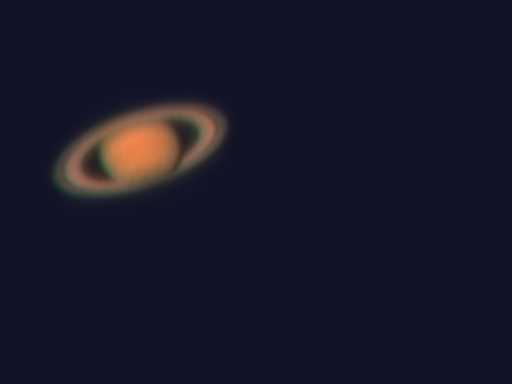
Subject: Some photos of mars Sent: Monday, October 13, 2003 06:20:07 From: nicolas.champaud@bnf.fr This two image were taken withe the following combination: an etx-125at scope and a toucam pro with an UV-IR cut filter and a 2x Barlow lense. Mars was took from my backyard in Versailles near Paris (rtespectivly the 25 and 29 sept)
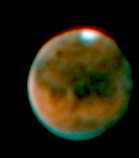
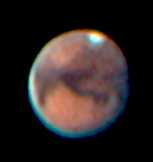
Subject: ETX-125 Imaging w/Orion Electronic Color Eyepiece Sent: Monday, October 13, 2003 16:58:21 From: MaxIPTer@aol.com Have a reasonable, cost effective solution to astroimaging that may be of interest to your visitors. It includes the Mighty ETX-125, an Orion Color eyepiece feeding the Snappy video digitizer. If you would like, I can put something together for your site. My pics include sun, moon, Mars, Vega, Aldebaran, and Altair. Got one of the Pleides last night..that would be a Plee-Ah-Dee I suppose. Here's some info that pretty much sums it up. Bottom line, the specs on the Orion eyepiece say it only goes to 2.5 lux and can be used for planetary and solar imaging only. These two bright star images seem to defy that information.I'm relying on the Snappy Video Digitizer to bring the images into my laptop. Snappy hardware, if you can find one, was really hot about 4-5 years ago. Basically it does an 8:1 oversample of the images in the highest resolution mode. The bad news is that if you're not rock solid on the tracking or mounts, the image is blurred. Recommend at least Snappy 3.0, then download the 4.0 firmware (freeware driver) which adds a nifty snap viewer so you can readily compare pics. The software has preview windows for precise focusing and all sorts of controls to bring in exactly the type of raw data you need. Bad news is Snappy is unsupportable as they are no longer in business. This is a real downside but since I already had the unit, I figured what the heck. Despite what the documentation says about only being able to image bright planets, the moon and sun, I brought in Vega, Altair, Aldebaran and one of the Pleiedes (would that be a Plee-ah-Dee) recently. If you have a field tripod, don't forget to use the wedge and equatorial tracking as opposed to Alt/Az. Because the Orion eyepiece behaves like a 7mm eyepiece (270x) it requires a really stable mount. Cobbling this rig together is very enjoyable and satisfying. The images will only keep improving. Can't wait to use the ETX in the equatorial mode...sort of overlooked that little point up to now. Clear Skies. Max 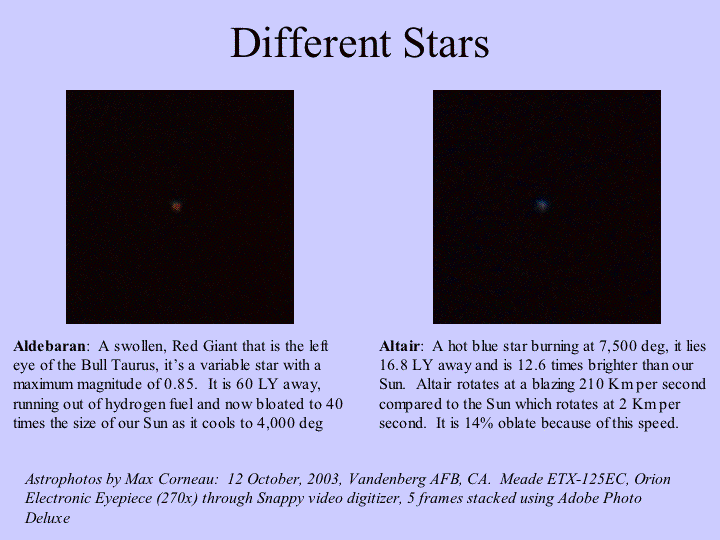
Subject: ETX Pictures Sent: Tuesday, October 14, 2003 19:14:41 From: Dennym31@aol.com Here is a picture of Saturn and Jupiter taken with ETX-90 R.A./ 2X barlow/ PC 164C b/w video camera / blue + green filter stacked/ MGI video creator / stacked and processed with K3CCD Tools.
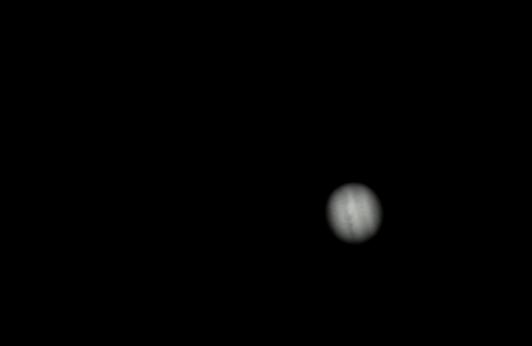
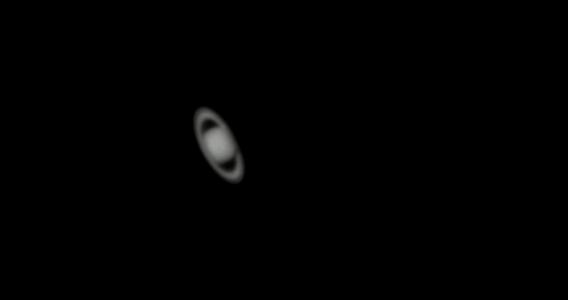
Subject: Any camera modifications Sent: Saturday, October 18, 2003 14:21:11 From: Tresfrijoles@aol.com Hi!! I was wondering if maybe you would have any knowledge of anyone, or yourself using a modified "3Com Home Connect" camera to take photos with the etx 125. Any information would be appreciated. Thanx, DuaneMike here: There is a lot of webcam info on the Helpful Information - Astrophotography page.
Subject: telescope pictures
Sent: Saturday, October 18, 2003 19:44:51
From: Dick.Sontag@bostikfindley-us.com (Dick Sontag)
Here are a few pictures I took with my 125 ETX and ToUCam Pro. Getting
better at processing with RegiStax.
Thanks
Dick Sontag
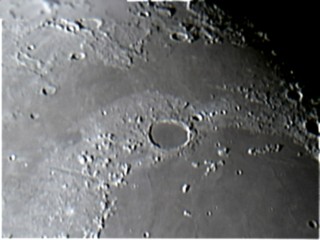
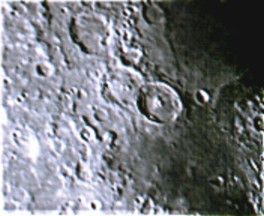
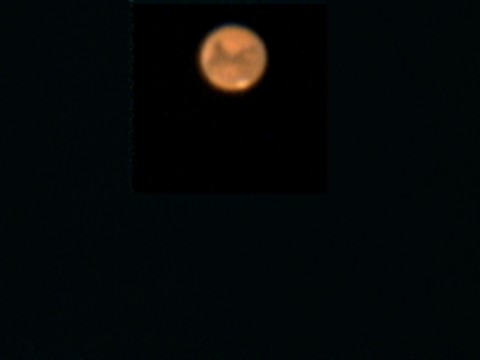
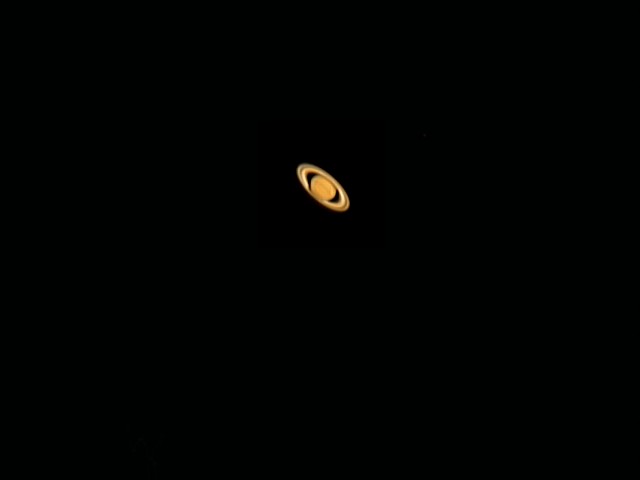
Subject: Saturne and Jupiter with an ETX125 Sent: Sunday, October 19, 2003 13:33:06 From: franck.bouquerel@planetis.com (Franck Bouquerel) First of all, congratulation for your web site ! Well, please find here two photographies : Authors = Franck BOUQUEREL and Florence CLEMENT Location = Lyon, France Date = October, 17, 4h30UT Meade ETX125 with barlow x2 WebCam TouCam Pro QC focus + RegiStax2 about 60 images for each
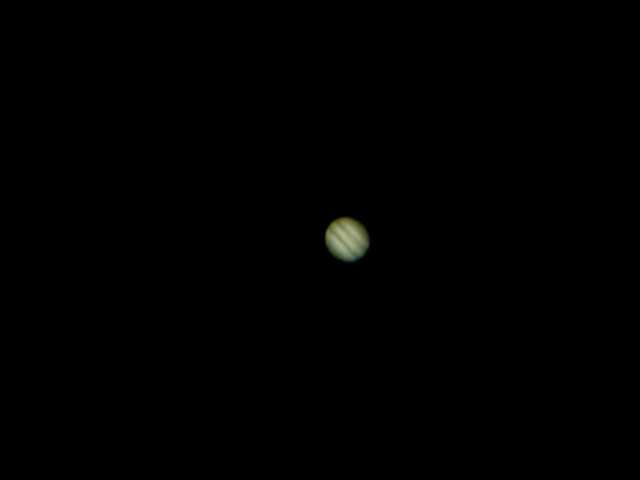
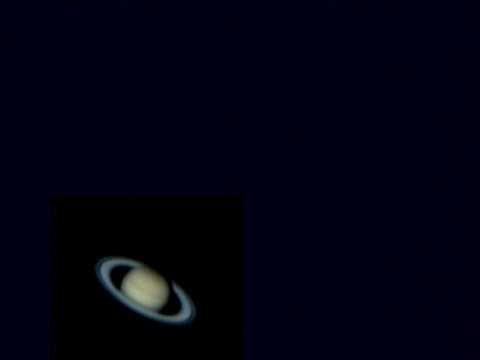
Subject: WG: Pictures of M31 and M51 for Deep Sky gallery Sent: Sunday, October 19, 2003 23:32:31 From: christian-hanke@t-online.de After a few frustrating nights chasing deep sky objectes, I was reasonable successfull recently . Octoberfest is over and the light pollution over southern Munich has improved a little bit. Nevertheless it is one of the limiting factors for urban deep sky backyard astronomers. The contrast is image quality significantly. There are some black traces visible in the pictures . The reason for that are a few hot spots in the CCD. The darkframe substraction leaves therefore dark traces, which give an information about the drift of the picture during exposure. The webcam brings a new quality in the use of the ETX, therefore I would like to thank all the people, which provide such helpful tips and software like K3CCD or Registax for hobby astronomers. They do really a great job! Again and again: Thank you for your great site! Regards Christian
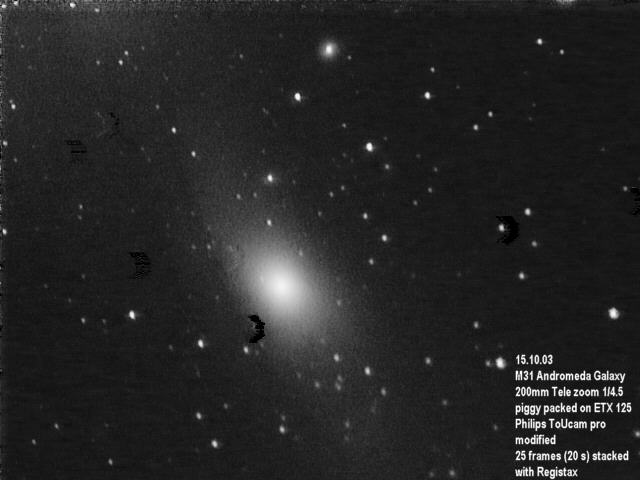
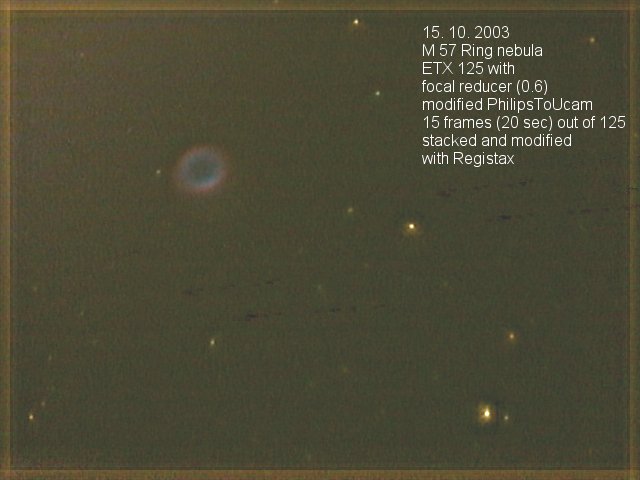
Subject: saturne Sent: Tuesday, November 11, 2003 09:10:14 From: YannHolmes@aol.com Here's my first shot of saturne. I got it from Paris on the 8 nov 2003. Taken with an ETX 105 EC, without autostar. ToUcam Pro. Barlow 2 x. Add of 360 out of 1800 pictures. Prism 5. Yannick Holmes
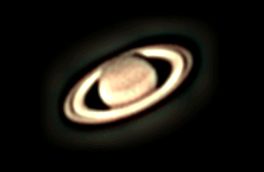
Subject: Saturn photos Sent: Monday, November 10, 2003 10:57:59 From: emailme@caramail.com (nicolas Champaud ) I took this images the 9 nov at 03:00, they were stacked with registrax. I used the following equipement: Etx-125+2xbarlow+toucam pro(1/25s, 10 frame/s)+uv-ir baader filter.
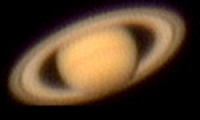
Subject: Saturn Photo Sent: Sunday, November 16, 2003 23:51:40 From: eyecstars@san.rr.com (charles falcone) This is my latest Saturn image taken November 16, 2003 with a ETX125EC and a Quickcam Pro 4000. It was taken at prime focus without any filters. AVI @ 5fps for 60 seconds then processed with Registax. The time was 10:30pm and the location was my backyard in San Diego, California. Charles Falcone www.falconect.smugmug.com/gallery/24016
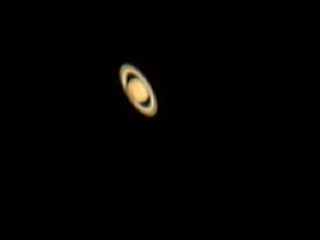
Subject: Planetary images taken with the ETX 125 Sent: Monday, November 17, 2003 03:41:23 From: CJansen@uebersetzungsbuero-jansen.de (Christoph Jansen) here is a "best of" excerpt of my planetary images for your guest astrophotography gallery. All images were taken with an ETX 125 at my home in Bad Zwischenahn, Germany (53 11' N, 7 58' E), in eyepiece projection with a 9,5 mm Meade 3000 Plossl and recorded using a Philips ToUCam Pro at 640*480 Pixels and 10 fps. Stacking and processing was done with Registax, some post-processing of histograms using Micrografix Picture Publisher 8. Both images of mars have a blue-channel re-synthesized using Gimp, as the original was unusable due to seeing effects and subsequent deformation during stacking. From left to right: Mars on Sep 24 2003, 21:42 UT at f=6000 mm (f/47); Mars on Sep 29 2003, 21:54 UT at f=5500 mm (f/43); Jupiter on Feb 16 2002, 18:30 UT af f=4000 mm (f/32); Saturn on Feb 16 2002, 19:00 UT at f=4000 mm (f/32). Regards, Christoph Jansen

Subject: Robo ETX90EC, Webcam and ScopeDriver Sent: Monday, November 24, 2003 12:12:48 From: howard.visser@cgi.com (Howard Visser ) It has been a long time since I last emailed you but let me start off by offering you my congratulations on your web sites 7th anniversary! Well done and many thanks for the countless hours you spend to keep this web site up to date for all of us to see and use. Through the resource information available on your site I was able to make the following decisions and acquire the right components for my scope: 1) Picking the ETX90EC was based on all the feedback available and recognizing the limitations (optical and mechanical) of this scope. It has turned out to be the right investment for me. 2) Investing in an electronic focuser was based on feedback from your website. I purchased one on e-Bay at a very reasonable price. 3) Acquiring an Autostar 495 also at a reasonable price and using the information and the safe load technique described on your website to turn it into an Autostar 497. 4) Wiring schematics so I could make my own cable to connect my computer to the Autostar. 5) Admiring all the images on your website and using these as a jumping off point to research web cam imaging and acquiring a Logictech QuickCam 4000 to do my own imaging. 6) Identifying all the tools required to do the imaging such as Registax for post processing, K2CCDTools capturing and processing images and QCFocus as a focusing aid and image capture utility. 7) And finally to acquiring ScopeDriver to automate the operation and control of my scope which as you read on will become very relevant. Without your website I wouldnt have come this far and certainly wouldnt have achieved as much. It has opened up a new realm of astronomy for me and has allowed to me to do the things I could only dream of as young astronomer some 35 years ago. Which leads me too today; the following is a composite of images that I have taken using my ETX90EC and web cam. All images were taken at prime focus and without the aid of a Barlow lens. Ive used both Registax and K3CCDTool to post process the images and do final touch ups and composition in Adobe Photoshop. The image of Mars was taken on October 4th at about 1:25 AM local time. The image of Saturn was taken on November 11th at 1:42 AM on what was probably the clearest evening Ive seen since I started imaging. Jupiter was captured at 7:46 AM local time on Nov 22nd. I was really thrilled with the outcome as both Saturn and Jupiter are first time images. Im still working on my technique but the instant gratification that web cam or CCD imaging offers has inspired me to do more. When I imaged Mars in October the weather was quite nice here in Edmonton, but it was sure to change and it did. Anticipating the colder weather I pursued the ScopeDriver option as a way to operate my scope from the warmth of my home. I had some initial struggles with the program but through the dedicated effort of Steve Hutson, ScopeDrivers author, many e-mails and using the information I could provide him, he was able to fix a long standing but isolated issue with the Autostar communications component of ScopeDriver. I highly recommend this product to those of you who are thinking of putting together your own Robo scope, the support I received was fantastic! Many thanks Steve! You can find out more about ScopeDriver at www.adpartnership.net/ScopeDriver. So with all the tools in place my first opportunity to image with my Robo ETX came in early November. Some initial trial and error work lead me to the evening of November 10th and morning of November 11th where I spent almost 4 hours imaging (with a 2 hour TV break in the middle) from the comfort of my kitchen using ScopeDriver to operate the scope which was sitting outside in the -5 degrees Celsius (23 Fahrenheit) weather. The scope, webcam and software worked well in spite of the cold. The operator was thrilled to stay warm (call me a fair weather astronomer) and was able to show some of the images of Mars to my wife and kids who were wondering what I was up too. They thought it was kind of neat too! Not to be outdone I wanted to capture an image of Jupiter and my chance arrived early on November 22nd. However the temperature had dropped significantly and on that morning it was -24 degrees Celsius (-11 Fahrenheit). I wasnt sure if I should and even how the scope would work in that cold weather but I pushed the scope out onto the deck, with a crude polar alignment and quickly centered Jupiter and started imaging once the scope started to cool off and settle out. With the sky starting to get lighter I tinkered with the focus using ScopeDriver and QCFocus, adjusted exposure parameters and started imaging. I was amazed that scope worked quite well during the hour or so that it was outside. I was able to track and adjust focus without a glitch, although once post processed I realized the focusing could have been slightly better or that the scope hadnt fully settled out. Ill continue to work on it and hopefully under better weather conditions but have proved that Robo ETX can and will work! Thanks again for the wealth of information your website has provided. I hope others will be as inspired as I am and experience all the fun that amateur astronomy has to offer! Cheers! Howard Visser Edmonton, Alberta
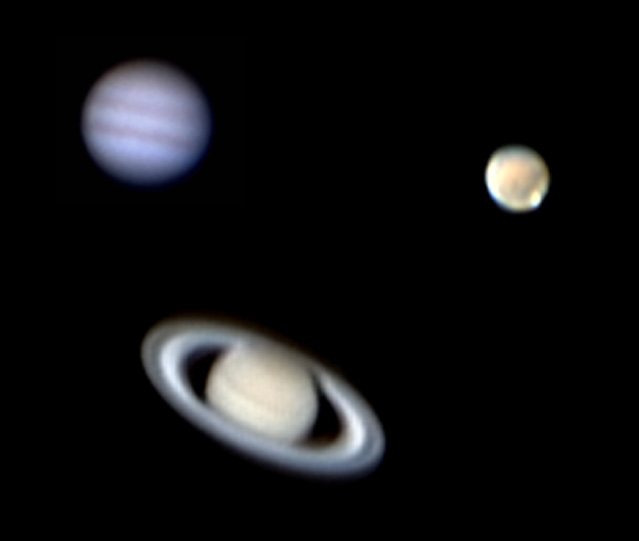
Subject: Photos Sent: Thursday, November 27, 2003 09:28:45 From: eyecstars@san.rr.com (Chuck) I hope your having a great Thanksgiving. I stayed up late last night, so after my dinner I'm looking forward to parking myself on the couch and snoozing. These are the photos I took using a ETX125 and a Quickcam at prime focus. AVI's at 5fps for 2 minutes. Stacked all frames using Registax. I'm please with the results. Jupiter was only 30 degrees above the horizon and Saturn was at zenith. Location was San Diego. It seems that I get the best results using little gamma and adjusting the gain to where it looks like the image will be to dark. Thanks for a great site. Clear Skies Chuck Falcone
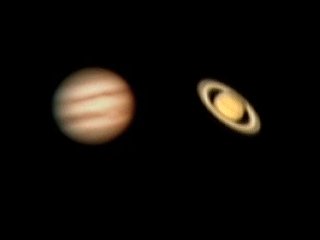
Subject: webcam piggyback Sent: Monday, December 1, 2003 06:12:24 From: geheniau@xs4all.nl For 4 weeks bad weather here. So working inside. I made this webcam adapter to use my webcam on my 70-300mm telelens for some wide deep sky. Piggy backed on my ETX90 for some better guiding. Waiting now for some clear skies. Job Geheniau The Netherlands
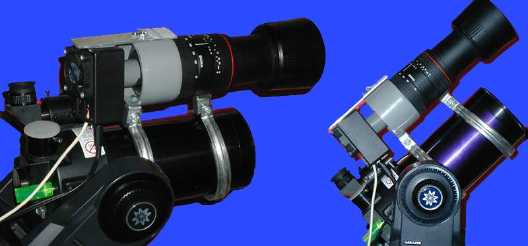
Subject: Helpful Information-Astrophotography-Webcam Sent: Tuesday, December 2, 2003 05:01:35 From: Dieter.Wolf@DNSint.com additional to your articles showing the size of Mars and Saturn with different scopes I would like to add an example of... 'What to expect from Saturn with ETX-125 and ToUCam' Now - during winter 2003 / 2004 - Saturn is situated very good for observation. It reaches opposition on December 31st, 2003 and is positioned high and bright in the sky. The ring system shows wide opened in our direction (southern hemisphere) with abt. 45x20" in diameter. With an ETX-125 (5", 1900mm) and a ToUCam the planet looks is as follows without a Barlow lense, with 2x Barlow and with 3x Barlow:Don't worry about false colors, less details, dark and 'fuzzy' view; it's a sample frame out of the avi-file. There may be better ones as well as worse. I decided to take the 2B-avi (there are VERY rare moments of best seeing where you can use the 3B; remember that equals magnification far over 600, but YES, sometimes it is possible) and resized by 2x / stacked / filtered / optimized / cropped by 0.5x the best 800 out of 1900 frames (with K3CCD tools & IrfanView) and this is the result (south up, east left):
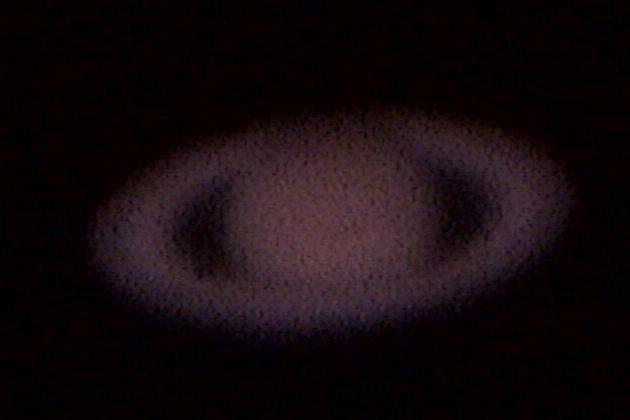
It's a nice one, but not optimal. Still a little grainy, so you can continue to optimize (or wait for a night with better conditions) But all that computer work takes a lot of processing power and user time! You see a nice, large ring system with the Cassini division, natural colors, the shadow of the plant on the rings and of the rings on the planet, a dark belt on the planet and the dark northern hemisphere. And yes, if you WANT you may imagine to see even a 'faint glimmer' of Encke minimum. But be careful; you easily may produce 'details' by 'enhancing' - where there are none! So that's what you can expect from Saturn with ETX-125 and ToUCam. Dieter Wolf (Munich, Germany) 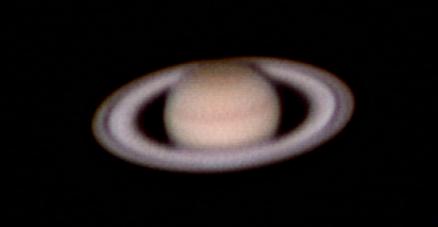
Subject: Astrophotography Gallery - Deep Sky Sent: Tuesday, December 2, 2003 08:21:27 From: Dieter.Wolf@DNSint.com Two famous - but very different - planetary nebulas. M57 - the Ring Nebula in Lyra - looks like what we 'expect' from a planetary nebula. It is relativeley bright, round and small. The innere part is not 'dark' as you can see in the photo.M27 - the Dumbbell Nebula in Vulpecula - is not so bright but larger. The 'dumbbell' form can be seen in the photo and the nebula looks more transparent. 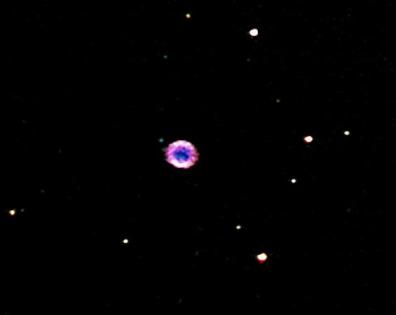
Dieter Wolf (Munich, Germany) November 23rd, 2003 MEADE ETX-70AT (70mm, 350mm) Philips ToUCam SC1 (prime focus) 45x10s exposures (M27) 80x6s exposures (M57) Always clear skies, Dieter 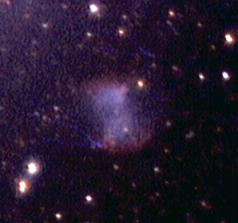
Subject: web cams Sent: Saturday, December 13, 2003 15:13:08 From: lexie53083@yahoo.com (bobbi pyle) love your site, i have an etx 90 and a web-cam that i would like to try and take some astro-photos with, but i don't have a lap-top. is there a way to get the telescope and camera outside connected to my p.c. inside. the max length to run a usb cable is 16 feet, but i would need to go a longer distance. thanx.Mike here: Well, you could buy a used, low-end laptop or small desktop.
Subject: Saturn pic - new user - first image From: "Justin J. Jerzak" (jjerzak@terrasite.com) Date: Mon, 22 Dec 2003 15:00:16 -0500 Hi, I just got my ETX and finally had a chance to try my hand at imaging. ETX125 - ToUCam Pro 840 26 mm eyepiece (73 X) Stacked and aligned in Regitax. Best regards, Justin Jerzak
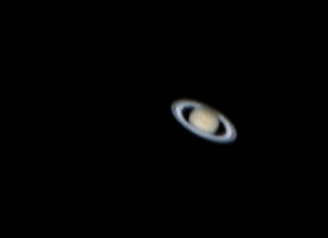
Subject: Contribution for your Gallery From: "Martin Sidgreaves" (martin.sidgreaves@wrigley.co.uk) Date: Tue, 23 Dec 2003 10:49:03 -0000 I'm pretty new to imaging using my ETX-90EC, but I was really pleased with this selection I have managed to get over the last couple of weeks. Thought I'd share them with you. Any comments or advice are greatly appreciated! Best Wishes & Clear Skies, Martin
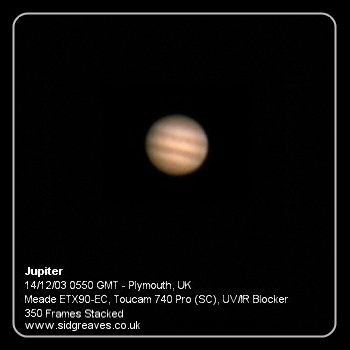
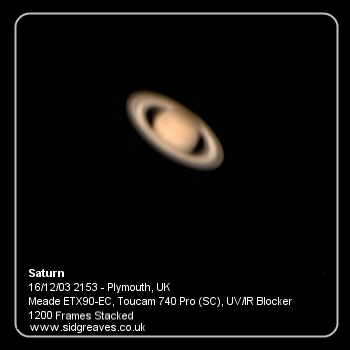
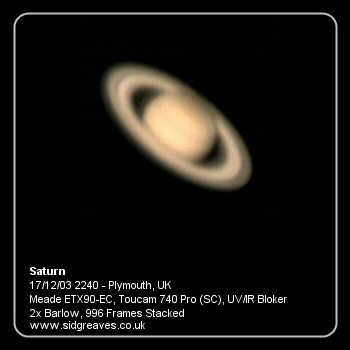
And:
Just wanted to say your book is fantastic!! I've even found the kids reading it too!! Many Thanks Martin
Subject: shot of Saturn 12 29 03 Date: 12/29/03, 18:19 From: mark mathosian (mmathosian@comcast.net) A shot of Saturn with the ETX90. Details: ETX90 and Philips webcam. No tracking. Stacked in Registax, about 150 images stacked. Imaged 12 29 03. Mark
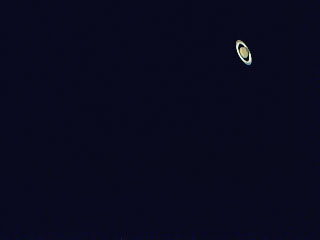
Return to the top of this page.
Go to the 2001-2002 Webcam Astrophotography Page.
Go back to the Astrophotography Page.
Go back to my ETX Home Page.